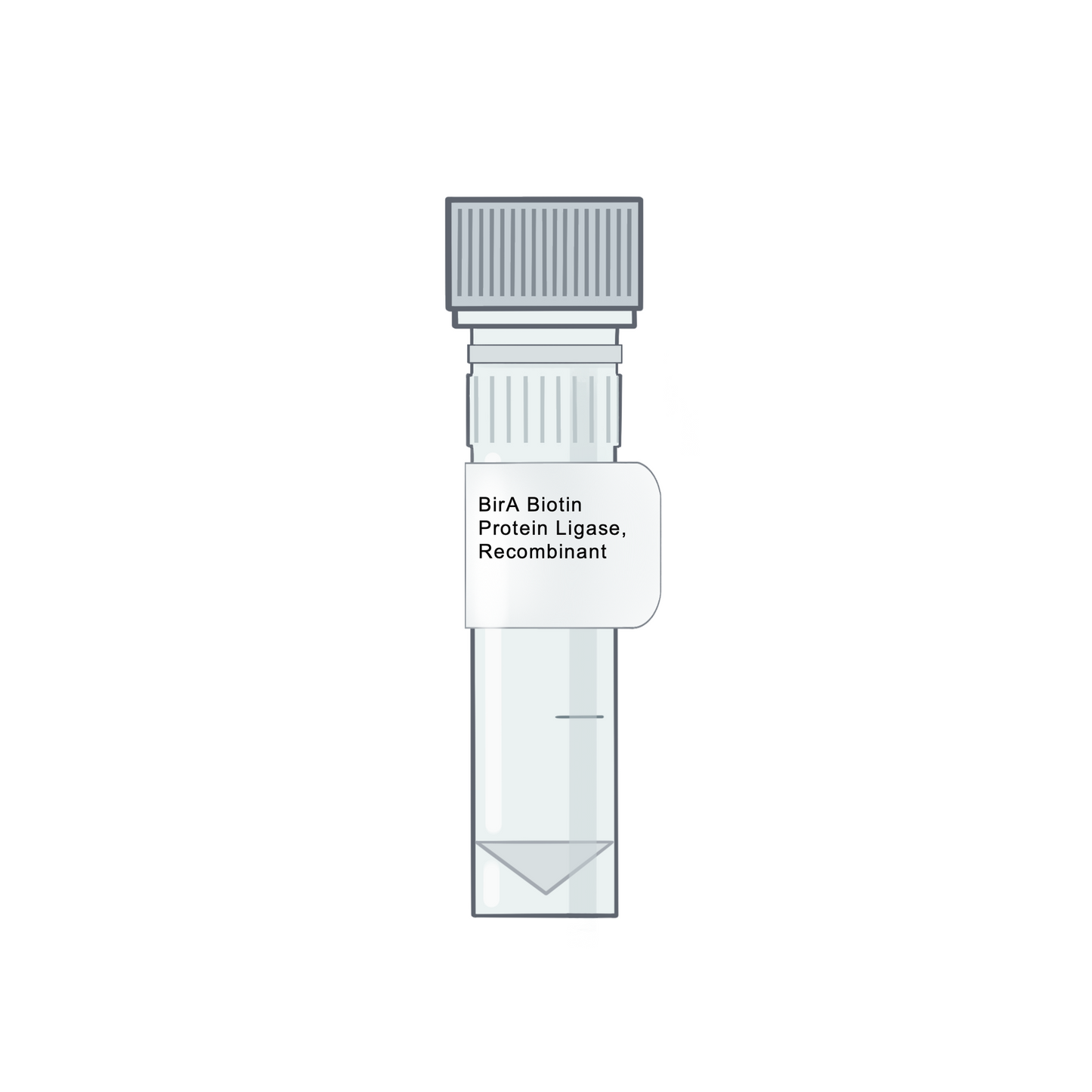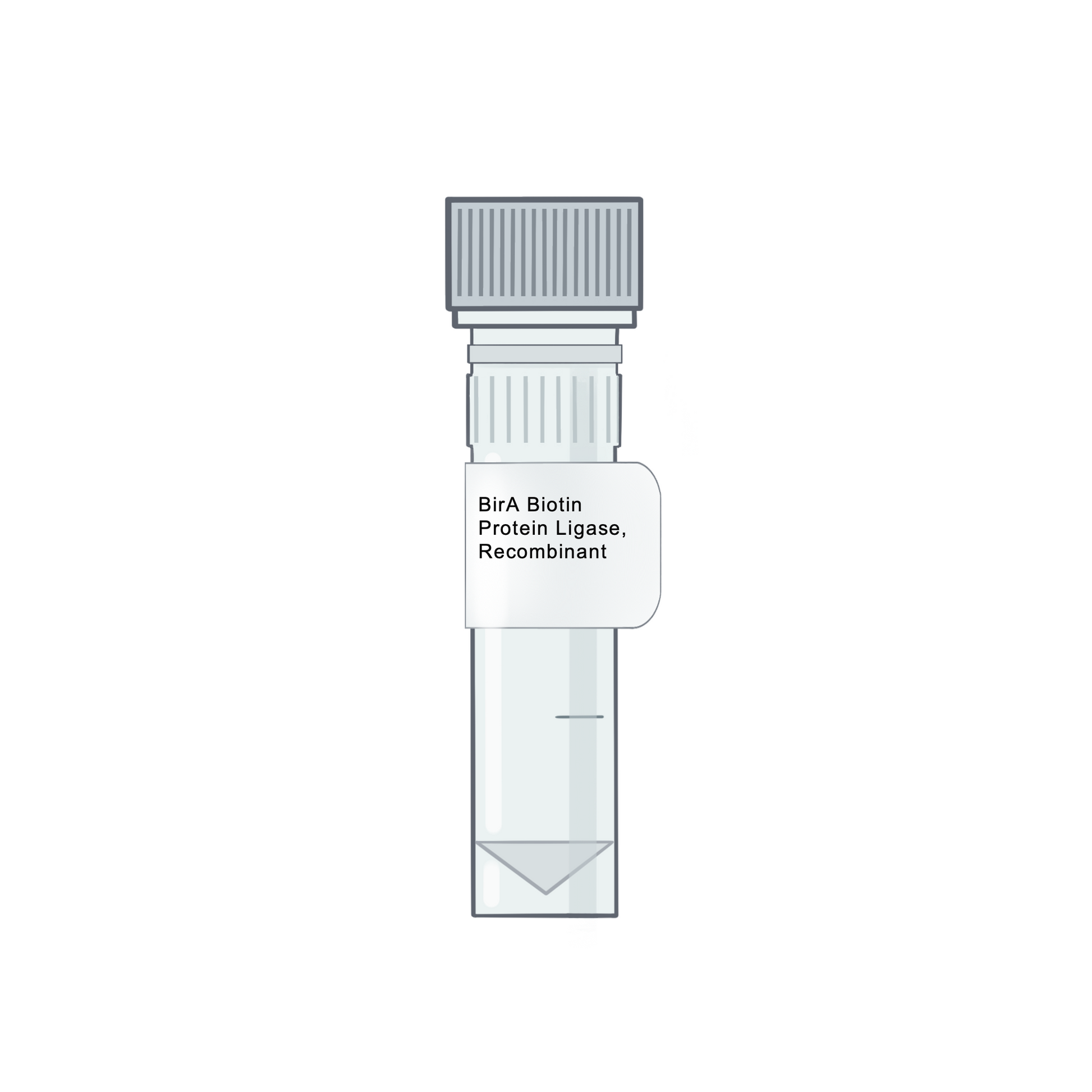BirA Biotin Protein Ligase, Recombinant
BirA Biotin Protein Ligase, Recombinant
Couldn't load pickup availability

E. coli Biotin Ligase BirA (EC 6.3.4.15) activates biotin to form biotinyl 5'-adenylate and transfers the biotin to biotin-accepting proteins and peptides. The natural substrate of BirA is the Biotin Carboxyl Carrier Protein (BCCP), requiring fusion of at least 75 residues to the target protein. However, several shorter peptide sequences have been described for BirA-mediated biotinylation such as 15 amino acids in length AviTag™ peptide (GLNDIFEAQKIEWHE). BirA site-specifically biotinylates a lysine side chain within this peptide. AviTag works at either the N or C terminus of the target protein.
BirA can be removed after biotinylation by running the reaction mixture through a Ni-NTA column if the substrate does not contain a His-tag.
Applications:
- In vitro biotinylation of proteins and peptides. The binding between biotin and streptavidin or avidin is one of the strongest known non-covalent biological interactions. The (strept)avidin-biotin interaction has been widely used for decades in biological research and biotechnology.
- Labeling of purified proteins by biotin is a powerful way to achieve protein capture, immobilization, and functionalization, as well as multimerizing or bridging molecules.
- Enzymatic biotinylation with BirA is more specific than chemical biotinylation which often generates heterogeneous products that may have impaired function.
Amid Biosciences also offers BirA Biotin Ligase version as a maltose-binding protein fusion enzyme (BirA Biotin Ligase, MBP Tag).
Catalog # BBL-301
This product is intended for laboratory research use only.
Expression system: E.Coli
Amino acids: 3-321
Tag(s): N-terminal His-tag
Molecular weight: 36.2 kDa
Storage buffer: 50 mM Tris-HCl, pH 7.5, 50 mM NaCl, 3 mM DTT, and 50% Glycerol
Concentration: 1.0 mg/mL by A280
Purity: >90% (SDS-PAGE, Coomassie staining)
Activity: 5,000 Units/µg
Definition of Activity: 1 Unit is the amount of enzyme that will biotinylate 1 pmol of AviTag peptide substrate in 30 minutes at 30°C in the reaction buffer containing 10 mM Tris-HCl, pH 8.0, 10 mM ATP, 10 mM MgOAc, 50 µM d-Biotin, and 38 µM peptide substrate.
Storage is recommended at -20°C for longer periods of time
Product Description and Manual
Shipping: Product requires shipping on dry ice. Please contact info@amidbiosciences.com for shipment estimates.
References:
- Mark Howarth & Alice Y Ting. Imaging proteins in live mammalian cells with biotin ligase and monovalent streptavidin. (2008) Nature Protocols 3: 534
- Askin et al. Green fluorescent protein-based assays for high-throughput functional characterization and ligand-binding studies of biotin protein ligase. (2016) Anal. Methods 8: 418
- Cai Huang and Ken Jacobson. Detection of protein-protein interactions using nonimmune IgG and BirA-mediated biotinylation. (2010) BioTechniques 49: 881
- de Boer et al. Efficient biotinylation and single-step purification of tagged transcription factors in mammalian cells and transgenic mice. (2003) Proc. Natl. Acad. Sci. USA 100: 7480
- Elif Nur Firat-Karalar, Tim Stearns. Probing mammalian centrosome structure using BioID proximity-dependent biotinylation. (2015) Methods in Cell Biology, 129: 153
Domestic Shipping in the US
Temperature sensitive products requiring shipping/handling on dry ice are shipped via UPS Next Day Air Saver. These products are delivered the next day if your order is placed before 3 PM PST. A dry ice surcharge is included in the shipping cost at checkout. For orders totaling over $1,000, free shipping and handling will be applied to the order.
International Shipping
Orders to be shipped internationally (outside of the US) can be shipped via DHL Express Worldwide or FedEx International Priority. Please contact info@amidbiosciences.com if you would like your company's shipping account to be used for the order. Our customers have sometimes negotiated lower shipping rates than us.
- Choosing a selection results in a full page refresh.
- Opens in a new window.

